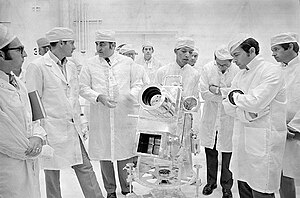George Robert Carruthers
| George Robert Carruthers | |
|---|---|

George Carruthers, center, discusses the Lunar Surface Ultraviolet Camera with Apollo 16 Commander John Young, right. From left are Lunar Module Pilot Charles Duke and Rocco Petrone, Apollo Program Director.
|
|
| Born |
October 1, 1939 Cincinnati, Ohio |
| Nationality | United States |
| Fields | physics |
| Notable awards | Arthur S. Flemming Award (Washington Jaycees), 1970 |
George Robert Carruthers (born October 1, 1939) is an African-American inventor, physicist, and space scientist. He has lived most of his life in Washington, DC.
From a young age he showed an interest in science and astronomy. He grew up in the South Side of Chicago where at the age of 10 he built his first telescope. Despite his natural aptitude, he did not perform well in school at a young age, earning poor grades in math and physics. Despite his poor grades he won three separate science fair awards during this time.
After graduating from Englewood High School he went on to get a bachelor's degree in aeronautical engineering from the University of Illinois in 1961, a master’s degree in nuclear engineering in 1962, and a doctorate in aeronautical and astronautical engineering in 1964. He now works with NRL’s community outreach organization, and as such helps support several educational activities in the sciences in the Washington D.C. area.
His work on ultraviolet spectrums and other types of astronautical tools helped him earn the Black Engineer of the Year award, of which he was one of the first 100 people to receive. His work has also been used by NASA, and in 1972 he was one of two naval research laboratory persons whose work culminated in the camera/spectrograph which was put on the moon in April 1972.
He is perhaps best known for his work with the spectrograph that showed incontrovertible proof that molecular hydrogen exists in the interstellar medium.
...
Wikipedia
